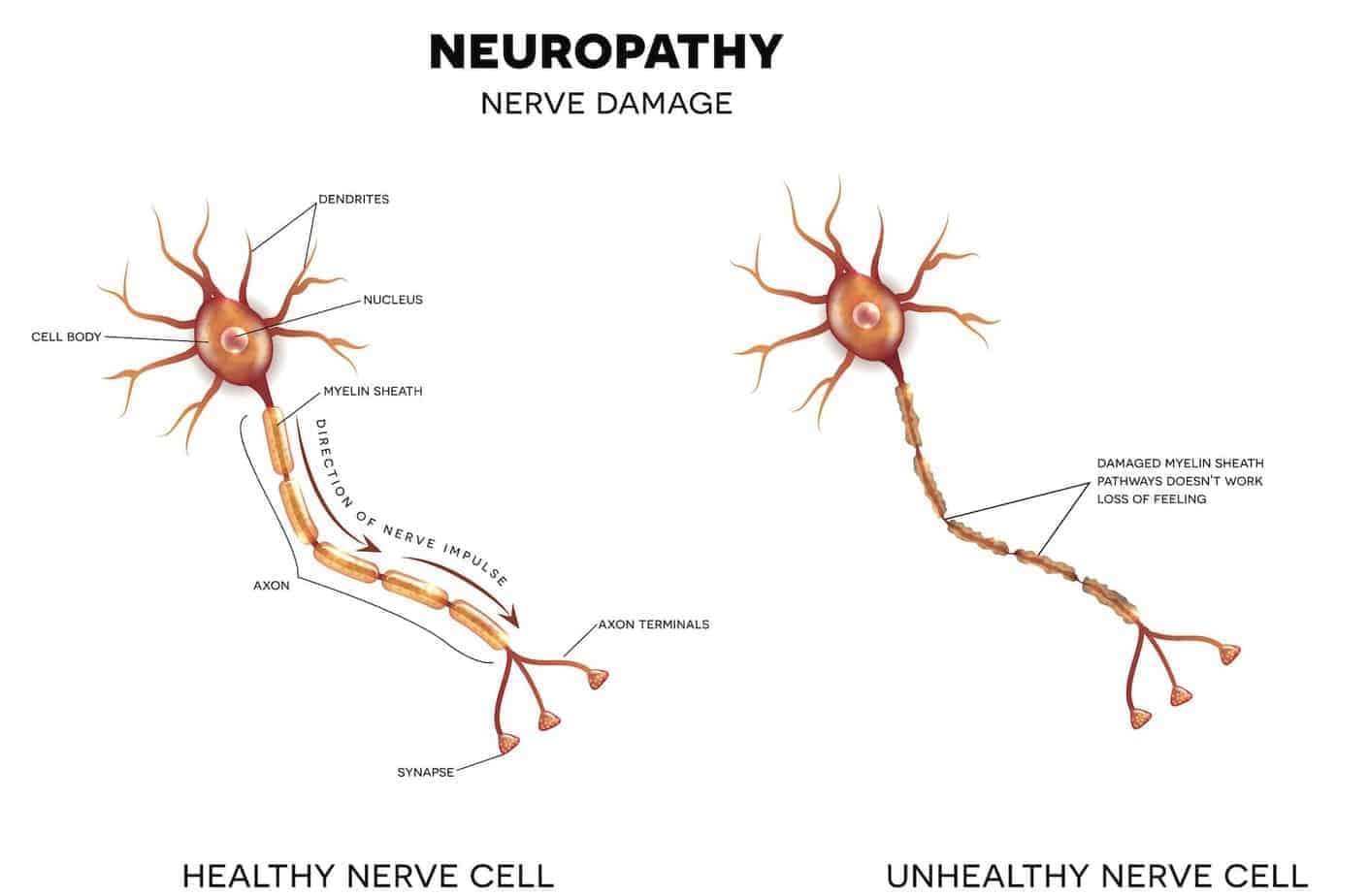Can Diabetic Neuropathy be Reversed, Cured, or Managed?

Diabetic neuropathy is a common yet severe diabetes complication. It affects about 50% of people living with diabetes. Symptoms vary from mild to debilitating, and difficulties can be as powerful as diabetic foot ulcers and lower limb amputations.
Nerve problems can appear in the first ten years of diabetes. So far, science has not found any ways to reverse diabetic peripheral neuropathy. But there’s a lot you can do to prevent its outbreak, slow down its evolution, lessen its symptoms, ease the pain, and stay away from further complications.
Table of Contents
What is Diabetic Neuropathy?
Diabetic neuropathy happens when high blood sugar levels damage the nervous system over time and interfere with the nerves’ ability to send signals to the brain. Too much glucose in the blood also weakens the small vessels that bring oxygen and nutrients to the nerves. There are four types of diabetic neuropathy.
Peripheral neuropathy
Peripheral neuropathy – also called distal symmetric peripheral neuropathy – is the most common type of diabetic neuropathy. It affects the peripheral nervous system from the lower limbs, feet, legs, and sometimes the hands and arms. Peripheral neuropathy may affect up to 50% of people with diabetes, and the pain it causes is commonly called “diabetic foot pain.”
Autonomic neuropathy
Autonomic neuropathy is also quite common among people with diabetes. The autonomic nervous system is responsible for controlling essential body functions such as breathing, heart beating, and digesting. Autonomic neuropathy usually affects the digestive system but can also affect the urinary system, the eyes, and the sexual organs. According to the National Institute for Diabetes and Digestive and Kidney Diseases (NIDDK), over 30% of people with diabetes have some autonomic nervous system deficiency.
Proximal neuropathy
Proximal neuropathy – diabetic polyradiculopathy or diabetic amyotrophy – usually affects the nerves in the thighs, hips, buttocks, or legs, often causing weaknesses.
Focal neuropathy
Focal neuropathy – mononeuropathy – is when damage is caused to a specific nerve. It commonly happens in the hands, head, torso, or legs, causing localized but severe pain. Carpal tunnel syndrome can result from diabetic focal neuropathy that affects around 25% of people with diabetes.
What are the Symptoms of Peripheral Neuropathy?
Because peripheral neuropathy is the one that affects most people with diabetes, we’ll focus on it for this article. Diabetic peripheral neuropathy symptoms vary from mild to extremely painful. You might experience all, some, or only one of the symptoms.
Numbness in the feet & legs
Numbness is probably the most common symptom of peripheral neuropathy. It’s a total or partial loss of feeling and sensation in the feet or hands. In the most severe cases, numbness can cause complications due to the inability to feel wounds or to be aware of the position of one’s feet.
Tingling, sharp pains, or cramps
Other people with peripheral neuropathy suffer from tingling or burning sensations in the feet and lower limbs or sharp pains and cramps. These symptoms can be mild discomfort for some or highly debilitating to others.
Increased sensitivity to touch
Another common symptom of peripheral diabetic neuropathy is an increased sensitivity to touch. In the worst cases, mere contact with sheets can be unbearable.
Foot complications, ulcers, and infections
Foot wounds, ulcers, and infections signify peripheral neuropathy in the feet. Due to loss of sensation and numbness, you may not notice that your footwear is causing sores or injuries. Unnoticed wounds can lead to infections and sometimes even diabetic foot ulcers if not taken care of.

Can Diabetic Neuropathy be Reversed?
Diabetic neuropathy can’t be reversed. The body cannot repair damaged nerves. However, early diagnosis and treatments are essential to stop the progression and reduce the risk of further harm.
There's no cure for diabetic neuropathy
Repairing damaged nerves depends on the cause of the nerve damage. Peripheral neuropathy caused by vitamin deficiency can sometimes be reversed with vitamin therapy. Nerve damage caused by alcohol abuse can also be improved with an alcohol-free lifestyle. Cut or damaged nerves from injuries can be repaired surgically.
But the nerves can’t regenerate when neuropathy is caused by diabetes and high blood sugar levels; there’s no cure for diabetic neuropathy.
Early diagnosis & treatment help stop neuropathy progression
Once damaged by diabetes, the nerves can’t be repaired, but an early diagnosis and an appropriate treatment considerably help slow down the progression of diabetic neuropathy and prevent further harm.
When living with diabetes, you should have a diabetic foot exam at least once a year. If you experience any of the above symptoms, immediately seek your doctor’s advice. Blood glucose control, physical exercise, a healthy diet, proper diabetic foot care, and sometimes medical treatments can prevent diabetic neuropathy from worsening. Meanwhile, there are lots of options to help relieve neuropathic pain too.

How to Relieve Diabetic Nerve Pain?
Damaged nerves can’t be repaired, and diabetic neuropathy is not reversible. But that doesn’t mean pain and symptoms can’t be relieved! Fortunately, many natural or medical methods help ease neuropathy symptoms and stop suffering.
Prescribed drugs
Severe cases of peripheral neuropathy may need prescribed drugs when other symptomatic treatments fail. Anti-seizure medications such as Gabapentin or Pregabalin can help relieve nerve pain. Antidepressants such as Amitriptyline, Doxepin, or Nortriptyline have also been found to help with neuropathic pain.
These medications are delivered under medical prescription only. They can have strong undesirable side effects. Always ask for your doctor’s advice first.
Topical nerve pain relievers
Relieving nerve pain from diabetic neuropathy is most often achieved by the local application of topical creams, gels, and lotions. Creams containing capsaicin or lidocaine have proven to work great. CBD-infused pain creams are also reported to have strong nerve pain relief effects. Some patients ease the pain with cooling creams containing menthol crystals.
You might have to try several neuropathy creams to see which works best for you. If you suffer from diabetic neuropathy, always ask your doctor’s advice before applying any lotion on your feet.
Shoes for diabetic neuropathy
When living with diabetic neuropathy, wearing appropriate footwear is essential. Diabetic shoes are professionally designed to alleviate foot pain and prevent complications from neuropathy. They’re non-binding with a protective interior that puts no pressure point on your feet. They provide extra support and promote pain-free motion. Neuropathy socks can also be a great addition if you suffer from foot neuropathy. They’re designed with a loose fit to help promote blood circulation. They’re usually seamless to prevent blisters and frictions and are crafted in moisture-wicking materials to keep your feet in a dry and healthy environment.
Massage helps with neuropathy
Massages also help with neuropathy. Massages have been used for centuries in every civilization for pain management, circulation booster, relaxation, and more. Foot massages can ease neuropathy symptoms and decrease the risks of complications in many ways. Massaging your feet regularly helps increase blood circulation, relieve pain, increase nerve sensitivity, reduce swelling, prevent foot ulcers, speed the wound healing process, and reduce the risk of blood clots.
Electrical nerve stimulation (TENS)
Transcutaneous electrical nerve stimulation (TENS) is a relatively new chronic pain and nerve disorder therapy that delivers low-voltage electrical impulses through the skin. It stimulates nerve fibers and reduces the transmission of pain signals from the nerves to the brain.
TENS has gained much popularity lately, and studies show that it helps relieve diabetic nerve pain. It’s a small machine. You can use it at home or book sessions with your doctor or physiotherapist.
Vitamins & supplements for neuropathy
Vitamins and supplements are often recommended to neuropathy patients. It’s unclear whether or not and to what extent they help prevent, treat, and alleviate diabetic neuropathy. But many people have reported the lessening of pain and the decreasing of symptoms intensity. Neuropathy patients usually use Vitamin B-12, Alpha-lipoic acid, Acetyl-L-Carnitine, N-acetyl cysteine, Curcumin, and Fish oil. Vitamins and dietary supplements for neuropathy must be part of a healthy and well-balanced diet. Always ask for your doctor’s advice first.
Foot soaks for neuropathy
Soaking your feet in warm water can help relieve neuropathic pain and boost blood circulation. It’s also an excellent opportunity to try other home remedies such as Epsom salts, essential oils, or medicinal herbs by adding them to your foot bath. However, soaking your feet must be done carefully if you have damaged nerves. It can also bring its share of complications.
Physical therapy and diabetic nerve pain
Physical therapy – also known as physiotherapy – is care that aims to ease pain and promote function and movement. It can be beneficial to neuropathy patients. A physical therapist may guide you toward nerve gliding, physical exercises, balance and coordination activities, education, and alternative solutions. Here’s a great physical therapy guide to peripheral neuropathy.
Herbs and essential oils for neuropathy
Alternative natural remedies such as herbs and essential oils have been used for centuries to relieve chronic pain. Some of them, such as Myrrh, Helichrysum Italicum, Frankincense, Peppermint, Basil, Chamomille, or Lavender, are believed to work great on peripheral neuropathy, alleviating its symptoms and helping to repair or stimulate the nervous system.
Acupuncture & neuropathy
Acupuncture is another alternative solution to manage neuropathy pain. This traditional Chinese medicine uses tiny needles inserted into the skin to stimulate the body’s healing abilities. Though research is still being conducted on the effects of acupuncture on nerve pain, some studies have shown that it enables the nervous system and releases endorphins to ease the pain naturally.
How to Prevent Diabetic Neuropathy?
As of today, there’s no cure for diabetic neuropathy. However, several steps and habits are needed to prevent it from appearing and slow down its evolution. With proper care and medical supervision, you can reduce your nerves’ damage and avoid most complications caused by diabetic neuropathy.
Good blood sugar management
Managing your diabetes and keeping your blood sugar levels in the range is crucial to prevent peripheral neuropathy or slow down its evolution. What causes damage to the nerves is the repetitive high glucose levels over time. Follow your doctor’s recommendations, check your glucose regularly, keep a healthy diet, and shoot for an A1C below 7%.
Healthy lifestyle
Alcohol, tobacco, and unhealthy foods don’t help with neuropathy. Following a healthy lifestyle, including physical exercise, does help prevent most diabetes complications including peripheral neuropathy.
Foot care
Foot care won’t stop neuropathy but it will definitely help prevent its complications and ease the symptoms. Diabetic neuropathy can cause serious complications in the feet and lower limbs such as sores that don’t heal, foot ulcers, and even amputations.
You should have your feet checked by professionals at least once a year and take good care of your feet at home. Check your feet daily, keep them dry and clean, and wear appropriate shoes for diabetes and neuropathy.